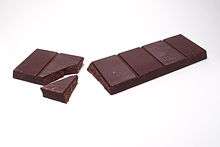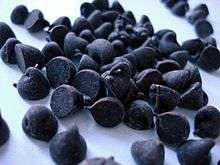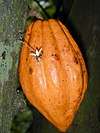Baking chocolate


Baking chocolate, also referred to as bitter chocolate,[1] cooking chocolate[2] and unsweetened chocolate,[3] is a type of dark chocolate that is prepared or manufactured for use as an ingredient in baking.[1]
Production
Modern manufactured baking chocolate is typically formed from chocolate liquor or cocoa solids former into bars or chocolate chips.[1] It is typically sold in bulk-sized 10-pound (4.5 kg) bars, which are then sold to confectioners and bakers.[2] Baking chocolate may be of a lower quality compared to other types of chocolate, and may have part of the cocoa butter replaced with other fats that do not require tempering.[4] This type of baking chocolate may be easier to handle compared to those that have not had their cocoa butter content lowered.[4] Lower quality baking chocolate may not be as flavorful compared to higher-quality chocolate, and may have a different mouthfeel.[4]
Varieties
It is typically prepared in unsweetened,[1] bittersweet[2] semi-sweet[5] and sweet varieties,[6] depending on the amount of added sugar.
Recipes that include unsweetened baking chocolate typically use a significant amount of sugar.[6] Bittersweet baking chocolate must contain 35 percent chocolate liquor or higher.[6] Most baking chocolates have at least a 50% cocoa content, with the remaining content usually being mostly sugar.[1]
Sweet varieties may be referred to as "sweet baking chocolate" or "sweet chocolate".[7] Sweet baking chocolate contains more sugar than bittersweet[6] and semi-sweet varieties, and semi-sweet varieties contain more sugar than bittersweet varieties.[7] Sweet and semi-sweet baking chocolate is prepared with a chocolate liquor content between 15 and 35 percent.[6]
The table below denotes the four primary varieties of baking chocolate.
| Type | Content | Sources |
|---|---|---|
| Unsweetened | Contains no sugar, and contains 99% chocolate liquor or cocoa solids. | [1][6][8] |
| Bittersweet | Usually has less sugar and more chocolate liquor compared to semi-sweet varieties. | [1][7][8][9] |
| Semi-sweet | Has less sugar than sweet varieties. In Europe, a regulation exists stating that semi-sweet varieties must contain more sugar and less chocolate liquor compared to bittersweet varieties. No such regulation exists in the United States, and due to this, semi-sweet and bittersweet varieties can vary in sweetness and chocolate liquor content. In the U.S., bittersweet varieties are even sometimes sweeter than semi-sweet varieties. | [1] |
| Sweet | Has the most sugar. | [6] |
Manufacturers
Manufacturers of baking chocolate include Baker's Chocolate,[10] Callebaut, Ghirardelli, Guittard, Lindt, Menier, Scharffen Berger and Valrhona.[2]
See also
References
- 1 2 3 4 5 6 7 8 Mushet, C.; Sur La Table; Caruso, M. (2008). The Art and Soul of Baking. Andrews McMeel Publishing. pp. 39–40. ISBN 978-0-7407-7334-1.
- 1 2 3 4 Risley, M. S. (2009). The Tante Marie's Cooking School Cookbook: More Than 250 Recipes for the Passionate Home Cook. Simon & Schuster. p. 370. ISBN 978-1-4391-4221-9.
- ↑ Patrick-Goudreau, C. (2007). The Joy of Vegan Baking: The Compassionate Cooks' Traditional Treats and Sinful Sweets. Fair Winds Press. p. 241. ISBN 978-1-61673-850-1.
- 1 2 3 Gisslen, W. (2012). Professional Baking. Wiley. p. 88. ISBN 978-1-118-08374-1.
- ↑ Gonzalez, E. (1998). The Art of Chocolate: Techniques and Recipes for Simply Spectacular Desserts and Confec Tions. Chronicle Books. p. 2. ISBN 978-0-8118-1811-7.
- 1 2 3 4 5 6 7 Better Homes and Gardens (2013). Better Homes and Gardens Baking: More than 350 Recipes Plus Tips and Techniques. Better Homes and Gardens Cooking. Houghton Mifflin Harcourt. p. 18. ISBN 978-0-544-17781-9.
- 1 2 3 Phillips, S. (2008). Baking 9-1-1: Rescue from Recipe Disasters; Answers to Your Most Frequently Asked Baking Questions; 40 Recipes for Every Baker. Touchstone. p. 162. ISBN 978-0-7432-5374-1.
- 1 2 Holmberg, M.; Editors of Fine Cooking Magazine (2009). Absolutely Chocolate: Irresistible Excuses to Indulge. Taunton Press. p. 4. ISBN 978-1-60085-133-9.
- ↑ Marcus, J. B. (2013). Culinary Nutrition: The Science and Practice of Healthy Cooking. Elsevier Science. p. 367. ISBN 978-0-12-391883-3.
- ↑ Goldstein, D.; Mintz, S.; Krondl, M.; Rath, E.; Mason, L.; Quinzio, G.; Heinzelmann, U. (2015). The Oxford Companion to Sugar and Sweets. Oxford University Press. p. 45. ISBN 978-0-19-931361-7.
Bibliography
| Wikimedia Commons has media related to Baking chocolate. |
| Look up baker's chocolate in Wiktionary, the free dictionary. |
- Sammarco, A. M. (2011). The Baker Chocolate Company: A Sweet History. History Press. ISBN 978-1-61423-113-4. 136 pages.
